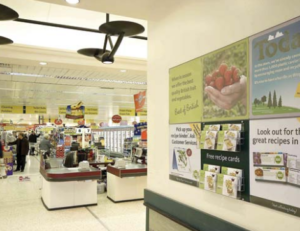My father worked for this retail giant for 30 years in the ’50s, ’60s, and ’70s. They started as a catalog retailer and grew to the place where everyone shopped. The fact that they started in catalog retail says they were close to online, yes? So it is hard to imagine how they lost the innovative retail recipe.

Sears, which long ago pioneered an early form of e-commerce through its catalog business, didn’t foresee a shifting landscape that started 25 years ago in Jeff Bezos’ garage in Seattle. They should have, yes?
While the U.S. retail giant could have carved out a strong presence in e-commerce, it failed to act back in 2005 when Amazon became the leading internet retailer. Instead, it launched its own big-box retail chains to try to turn the tide on market share loss from Walmart, Target, and others. Wrong turn, yes?
Eleven years later in 2016, former CEO Eddie Lambert who stepped down after Sears filed for bankruptcy last month, warned of disruption to retailers like “Walmart, Nordstrom, Macy’s, Staples, Whole Foods and many others have felt the impact of disruptive changes from online competition and new business models.”
In 1892, George Eastman formed the Eastman Kodak Company to “make the camera as convenient as a pencil.” It was an idea whose time had come and by the early 20th century, Kodak emerged as one of America’s largest companies and Eastman one of its most successful entrepreneurs.
It wasn’t just that one idea that made the company so successful, it managed to stay on the bleeding edge for over a century, pioneering impressive new advancements in photographic paper, development and image processing. In 1975, it invented the digital camera, which would lead to its downfall as a major corporation.
The problem wasn’t that Kodak didn’t understand the potential, but that it became stuck in its operating model. It was so huge and so profitable, that almost any other opportunity seemed small by comparison.
While Kodak is an extreme case, many others fail in new markets for similar reasons, they fail to bridge the gap between innovation and operations.
Like many others struggling to survive like Toys “R” Us, JCPenney and Macy’s, Sears is closing 142 unprofitable stores by the end of this year.
Insights on Sears.com traffic and conversions
To better understand Sears’ under-performance in the rising e-commerce economy, take a look at analyzed data from Jumpshot’s panel of 100 million devices that tracks more than five billion consumer actions per day.
The data ranges from January 2017 to September 2018. One key finding is that Sears has barely grown online transaction volume for nearly two years.
Through September, it posted almost exactly the same number of purchases, growing just 0.03% year over year. Traffic to the site has been declining. It’s down 16% for the year.
The failure of Sears’ private-label strategy
The value for Sears’ historically strong brands like Craftsman, DieHard, and Kenmore has lost its luster. The retailer manufactured or sourced high-quality products to earn the lasting trust that spanned generations and used them to generate loyalty.

But, Sears failed to realize it could not rely on brand affinity forever, especially since brand loyalty is prevalent mostly among older generations who are the majority of Sears’ customer base. Instead, it’s limped along using the goodwill it’s generated to maintain sales or sell off its brands as assets.
In comparison, Amazon’s winning private-label strategy has focused on acquiring retail dominance and then moving in on established brands with its own often cheaper and lower-quality products to squeeze out the competition.
Jumpshot data shows that Sears’ strongest categories online are tools, appliance, and shoes. Combined, they account for about half the transactions on Sears.com.
The tools category was a bright spot for Sears. It grew 50% year-over-year growth last year and Sears.com is the fourth-ranking domain in the category behind Amazon, Walmart and Home Depot.
But, 84% of tools purchases on Sears.com are driven by one brand, Craftsman, which represents about one-fifth of all online sales for Sears.
Though they’ve sold the brand to Stanley Black & Decker, Sears has wisely retained licensing rights for its most valuable brand for another 14 years.
Unfortunately, Sears performance for online sales in its two other top categories, appliance, and shoes, is underwhelming compared to competitors.
Why Amazon Is Most Innovative Company? Our Answer May Surprise You
Its Kenmore brand drives 62% of all appliance sales on Sears.com, but appliance sales have been flat so far this year, down 0.1% year-over-year through the end of Q3. It ranks ninth in market share with only a 1.6% sliver of the pie by domain.
Amazon outpaces the pack with a 69% market share in the category. Others ahead of Sears in online appliance sales include Walmart, Home Depot, Lowes, Kohls, Best Buy and Bed Bath & Beyond.
Going from bad to worst
Sears’ performance in the shoe category is far worse, and most of the traffic it is generating is tied to legacy brand DieHard boots.
Four of the top six keywords leading to interactions with the brand include the DieHard name, and it’s paying for consumers’ attention with nearly half of its traffic from those keywords being driven by paid ads. Overall, Sears.com is ranked 17th among a crowd of competitors for market share by domain.
Innovative retail recipe … lost innovative spirit
Sears became a retailing juggernaut via innovation. When general stores were small and often far between, and stocking inventory was precious, Sears invented mail order catalogs.
Over time almost every home in America was receiving 1, or several, catalogs every year. They were a major source of purchases, especially by people living in non-urban communities.
Then Sears realized it could open massive stores to sell all those things in its catalog, and the company pioneered very large, well-stocked stores where customers could buy everything from clothes to tools to appliances to guns.
As malls came along, Sears was again a pioneer “anchoring” many malls and obtaining lower cost space due to the company’s ability to draw in customers for other retailers.
To put it mildly, Sears was the most innovative retailer of all time. Until the internet came along.
Focused on its big stores, and its breadth of products and services. Sears kept trying to sell more stuff through those stores, and to those same customers. Internet retailing seemed insignificantly small, and unappealing.
Heck, leadership had discontinued the famous catalogs in 1993to stop store cannibalization and push people into locations where they could promote more products and services.
Focusing on its core customers shopping in its core retail locations, Sears leadership simply ignored upstarts like Amazon.com and figured its old success formula would last forever.
But they were wrong. The traditional Sears market was niched up across big box retailers like Best Buy, clothiers like Kohl’s, tool stores like Home Depot, parts retailers like AutoZone, and soft goods stores like Bed, Bath & Beyond.
Innovative retail recipe … manage-by-trends
Mr. Lampert was a finance expert and former analyst turned hedge fund manager and investor. He truly believed that if he had enough numbers, and he studied them long enough, company success would ensue.
Unfortunately, trends often are not reflected in “the numbers” until it is far, far too late to react.
The trend to stores that were cleaner, and more hip with classier goods goes back before Lampert’s era, but he completely missed the trend that drove up sales at Target, H&M and even Kohl’s because he could not see that trend reflected in category sales or cost ratios.
Merchandising – from buying to store layout and shelf positioning – are skills that go beyond numerical analysis but are critical to retail success.
By focusing on numbers, rather than trends, Sears was constantly reacting rather than being proactive, and thus constantly retreating, cutting stores and cutting product lines.
To gain more insight, take a look at Jeff Bezos

Mr. Bezos focused on trends, and what was needed to make his business grow. Retail was under change, and that change was being created by technology.
Streaming content, live content, user-generated content, 24×7 content posting (vs. deadlines,) user response tracking, reader interactivity, social media connectivity, mobile access and mobile content — these are the trends impacting retail today.
So Mr. Bezos pushed for hiring more engineers – a lot more engineers – to build apps and tools for readers to interact with the company.
In the retail market, Amazon is growing because it is using trends to transform itself into a company readers (and advertisers) value.
The bottom line
CEO Lampert could have chosen to transform Sears Holdings. But he did not. He became a very, very active “hands-on” manager. He micro-managed costs, with no sense of important trends in retail.
He kept trying to take cash out when he needed to invest in transformation. He should have sold the real estate very early, sensing that retail was moving online.
He should have sold outdated brands under intense competitive pressure, such as Kenmore, to a segment supplier like Best Buy. He then should have invested that money in technology.
Sears should have been a leader in shopping apps, supplier storefronts, and direct-to-customer distribution.
Focused entirely on defending Sears’ core, Lampert missed the market shift and destroyed all the value which initially existed in the great merger he created.
